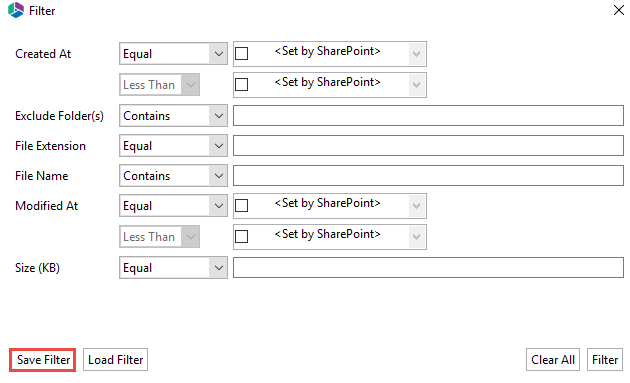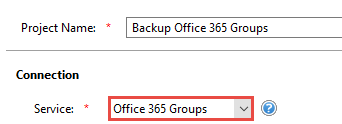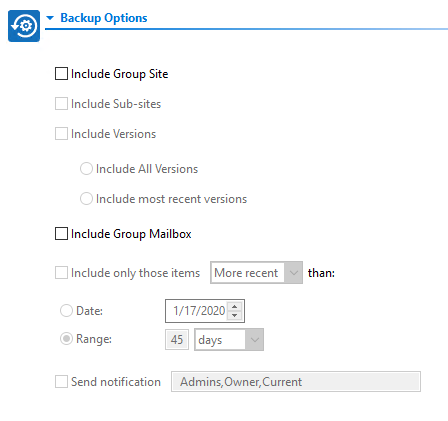Restore OneDrive Classic Backup
The following are instructions for restoring a OneDrive List/Library from a specific backup:
1.Navigate to the backup, You can access the Restore wizard by either right-clicking on the selected username and selecting the "Restore" option
Or you can access the Restore Wizard by selecting "To Original Location" in the Restore section of the Ribbon.
2.The Restore Backup wizard will now be generated.
3.You can choose from the following configuration options:
List Name and Properties - you can choose to change the list name and profile.
List Copy Options
Copy Content Types - restore the content types contained within the list backup.
Copy Content - restore the content within the list/library backup.
Copy Content Permissions - restore the permission settings of the content within the list/library backup.
Copy Versions - copy the version of the content included within the list/library. You can specify if you would like to include all versions of the content, or whether you would like to include the most recent number of specified versions of the content.
Copy List Permissions - select this option to copy the list/library permissions.
Copy Views Views - select this option if you would like to copy the number views of the list/library.
Advanced Options
Overwrite if file exists - In a version library, selecting the "Overwrite if File Exists" option does not overwrite the files already in the OneDrive. OneDrive will append these to the list as new versions.
Incremental Copy - Incremental or delta migrations are an important and powerful option for large or ongoing projects and migration validation. Once enabled this option will migrate new, modified or versioned content from the source to the destination, capturing changes made by users during the previous migration.
The value entered into the "Last" field will limit the amount of content examined to the time period specified, starting at present time.
To perform an incremental migration, enter the amount of time to include and select the appropriate time period in days, weeks or months. Incremental migration is designed to be used in scenarios where the destination is not being modifed.
To perform a delta migration, enter zero in the field and select days as the time period. Delta migration is designed to be used in scenarios where both the source and destination may be modified during the course of the migration. Please note that a delta migration compares dates between source and destination to determine which content to include, so it will take more time to process than an incremental migration.
|
|
NOTE: The Overwrite if File Exists parameter will be disabled if this option is selected. |
Enable Azure Turbo Mode - When enabled, this option utilizes Microsoft's SharePoint Online Migration API to increase the migration performance and throughput. A recommendation for optimal use of this API is larger sets of data; the more content, the better the throughput. Because this API uses Azure storage as a staging area for the migration, it requires that you provide an Azure storage location. The options are to either utilize Microsoft supplied storage or to provide your own Azure storage location. If you wish to use your own Azure account, you must provide both the Azure Account Name as well as the corresponding Access Key. If you cannot supply this information, please search our online Knowledge Base, User Manual, or contact Support for additional information before proceeding or consider using the Microsoft Supplied Storage option. For more information please see the Azure Turbo Mode section.
Apply Filter - Filters allow the inclusion or exclusion of items by user defined criteria, such as date, size, file extension, file name, or file owner.
Please note that the Apply Filter functionality is only applied to selected containers (i.e. site, lists or folders). If you select specific content (documents or items) then those objects will be included with the operation regardless of the filter applied. If you want to selectively include content, please select the container that this content resides in and apply the filter or apply the filter against the container first, then select the remaining content.
For the File Extension and Exclude Folders parameters only, you can use "," to set more than 1 criteria. For example, use this format "png,docx,pptx" to include multiple file extensions.
"Size" filter should have a whole number without decimals. It recommended not to use operators "Equal" and "Not Equal" to avoid difficulties with accurate file size if it more than 1 MB.
Use "Save Filter" option to save filter settings to file and load it in different wizards or Profile Manager. Note that filter file and filter fields have to match. For example, set of fields in filter will be different if you copy file into two different libraries.
Re-Map Users - This option will allow you to map users between different domains or to change the user account in the target environment during copy.
Re-Map Site and List Templates - This feature allows for the re-mapping of list or site templates.
Remove WEB Elements - This option allows you to remove specified webparts and namespace references from all included pages during migration.
The webpart and namespace references to be removed should be defined in a CSV file and then loaded with this option.
7.Once you have configured all of your settings, click Finish to complete the restore.
|
|
NOTE: By default the restore process will put all the content, metadata, site/list structure, permissions and other supported objects back into the original backup location. |
Classic Office365 Groups Backup
Essentials for Office 365 Backup is a simple and easy to use backup tool that empowers administrators and power users to efficiently backup, archive, and restore their content from SharePoint, Office 365 SharePoint Online, OneDrive for Business sites, and Exchange Online mailboxes (when licensed). With Backup, you can quickly retrieve individual items or entire sites.
·Site Backup: Backup and extract site collections, sites, lists and libraries, documents and versions, permissions, views, column groups, fields, terms, and content types in SharePoint or Office 365.
·OneDrive for Business Backup: Backup and extract content, versions and SharePoint permissions from one or more users' OneDrive for Business Documents library within your Office 365 tenant.
·Exchange Online Mailbox Backup: Backup and extract messages, folders, calendar events, tasks and more from one or more users' Exchange Online Mailboxes within your Office 365 tenant. This feature is automatically disabled and must be manually enabled.
·Cloud Storage: Backup and Restore to/from Azure and Amazon S3
·Extract: Extract legacy or orphaned content from SharePoint and Office 365 to a file system based on specific search and filter criteria of your choice.
·Restore: Restore content to existing SharePoint or Office 365 site collections, sites, list and libraries, and folders without rolling back the entire SharePoint farm. (Cannot be used for Migration. Choose Essentials for Office 365 migration for the best results)
·Ensure High Availability: Access critical content and ensure continuous 24x7 business operations in Office 365 and other hosted environments in the event of a service interruption through local backups.
·Rapid Item Level Restore: Granularly restore selected SharePoint items from the local backup copy with the option to include metadata, versions, and authorship properties.
·Schedule Backups: Use Windows scheduler to run full or incremental backups from PowerShell or the command line as a part of larger batch jobs.
|
|
NOTE: As with any Backup solution, it is strongly recommended that you thoroughly test the solution in a non-production environment prior to running any operations against your production data. Make note of all backed up and restored objects, their behavior, the process itself, scheduled operations as well as the results. If at any time you have additional questions about objects and functionality, please open a ticket with support for additional information. |
Creating Office 365 Groups Classic Backup
In order to perform the Office 365 Groups Backup as a Classic Backup you must first turn off Hyper Backup.
Essentials Backup supports the ability to create a backup of any single, or all, Office 365 Group sites:
1.Press the "To Local Storage" or the "To Cloud Storage" button located in the ribbon. This will generate the Backup Properties screen.
2.Enter a project name for your Backup, this name will be displayed in the Backup Navigator.
3.Under the Connection section of the wizard, select "Office 365 Groups" as your Service type.
4.Enter your Global Administrator username and click the Connect button.
5.When prompted, enter your Global Administrator password and click Connect.
|
|
NOTE: To backup all Office 365 Groups sites you will need to enter your Office 365 Global Administrator login and password. Please note that this Admin user account must have an Exchange Online license assigned to it in order to be successful. |
1.You can choose to "Include all Office 365 Groups", which will create a backup of all of your Office 365 Groups, or you can select to specify which Office 365 Groups you wish to backup by either loading a list from a CSV file (by clicking Load from CSV), or selecting from a list provided by clicking Select from Office 365.
6.Choose your desired Backup, Retention, and Location options (Note: a location must be specified in order to continue) and click Finish to begin. For information on how to connect to Cloud storage, see the Connecting to Cloud Storage section.
Backup Options
Include Group Site - include the group site in the backup of the office 365 group.
Include Sub-sites - include sub-sites in the backup of the office 365 group.
Include Versions - this option will allow you to specify how many versions of each item to include with the backup. If left unchecked, no versions will be included, if "Include All Versions" is selected then all versions will be included. If "Include Most recent versions" is selected then only the number of versions specified will be included, starting with the most recent and working backwards (major and minor versions are included).
Include Group Mailbox - include the group mailbox in the office 365 group backup.
Include only those items - This "Include Only" filter allows the configuration of which items, based on creation date, should be included with this backup.
The filter provides the following four scenarios. Please note that using this filter will also dictate which items are included in updates (Full, Differential and Incremental).
Include only those items "more recent" than a specified date. When this is configured, the backup will only include items created from today back until the specified date. It will never include items that were created prior to this date since the starting point (the specified "Date") has been explicity defined.
Include only those items "more recent" than a range. When this is configured, the backup will only include items created from today going back to the number of days, weeks, months or years configured. Both the today date and the starting point are dynamic and will vary based on the operation's start and end times.
Include only those items "older" than a specified date. When this is configured, the backup will only include items created prior to the specified date. In this configuration, since both the start and end dates are explicitly defined updates are unnecessary as the included items will never change. This option should only be used for a one-time backup operation.
Include only those items "older" than a range. When this is configured, the backup will only include items created prior to the specified date going back to the number of days, weeks, months or years configured. Both the starting date and the ending point are dynamic and will vary based on the operation's start and end times.
Send Notification -Enter a specific user email address. For two or more, separate each email address with a comma. Email(s) would be used in email notifications and in send test email option.
Retention Policy
Keep Full Backups - if configured, this will specify how long the software will retain any Full backups that were created in this project. The retention purge will occur at the start of the next run or scheduled backup update for each project which contains a configured retention policy.
Keep Incremental Backups - if configured, this will specify how long the software will retain any Incremental or Differential backups that were created in this project. The retention purge will occur at the start of the next run or scheduled backup update for each project which contains a configured retention policy.
Save Backup to Location
Keep Full Backups - if configured, this will specify how long the software will retain any Full backups that were created in this project. The retention purge will occur at the start of the next run or scheduled backup update for each project which contains a configured retention policy.
Keep Incremental Backups - if configured, this will specify how long the software will retain any Incremental or Differential backups that were created in this project. The retention purge will occur at the start of the next run or scheduled backup update for each project which contains a configured retention policy.
Include Only Backup Filter
When configuring the initial backup job, you may choose to apply an Inclusion filter against the content within the selected mailbox folders. This filter is based on the modification date of each item within the group and is designed to Include the content within the specified time period (by Date or by Range), not Exclude.
Please review the following scenarios to determine which setting is best for your backup needs. Please note that the initial filter configuration will impact how Updates (Full, Incremental, and Differential) are performed, so choose wisely.
Each configuration includes a chart displaying what will be included (green bar) versus what will be excluded (red bar). The bar on the bottom represents the initial Full backup and each above it represents the updates that can be performed.

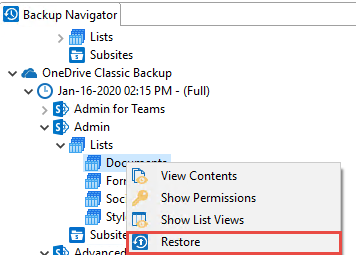


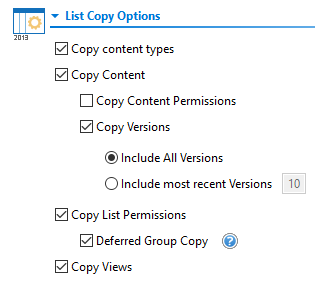
![restore spo classic backup 7]](/fr-fr/technical-documents/image/a00c35b5-a286-4f20-80d5-8a77273bc47b)

